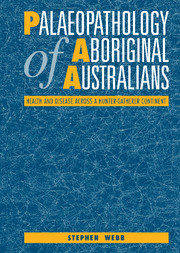Book contents
- Frontmatter
- Contents
- List of illustrations
- List of tables
- Acknowledgements
- 1 Introduction
- 2 Australian palaeopathology, survey methods, samples and ethnohistoric sources
- 3 Upper Pleistocene pathology of Sunda and Sahul: some possibilities
- 4 Pathology in late Pleistocene and early Holocene Australian hominids
- 5 Stress
- 6 Infectious disease
- 7 Osteoarthritis
- 8 Trauma
- 9 Neoplastic disease
- 10 Congenital malformations
- 11 Motupore: the palaeopathology of a prehistoric New Guinea island community
- 12 The old and the new: Australia's changing patterns of health
- References
- Index
4 - Pathology in late Pleistocene and early Holocene Australian hominids
Published online by Cambridge University Press: 21 May 2010
- Frontmatter
- Contents
- List of illustrations
- List of tables
- Acknowledgements
- 1 Introduction
- 2 Australian palaeopathology, survey methods, samples and ethnohistoric sources
- 3 Upper Pleistocene pathology of Sunda and Sahul: some possibilities
- 4 Pathology in late Pleistocene and early Holocene Australian hominids
- 5 Stress
- 6 Infectious disease
- 7 Osteoarthritis
- 8 Trauma
- 9 Neoplastic disease
- 10 Congenital malformations
- 11 Motupore: the palaeopathology of a prehistoric New Guinea island community
- 12 The old and the new: Australia's changing patterns of health
- References
- Index
Summary
Introduction
The paucity of information about late Pleistocene palaeopathology from the region is a severe handicap to those trying to put together a picture of the health of the first Australians. Therefore, I want to present this chapter as a beginning in our effort to change that situation and develop an understanding of ancient health in this part of the world. I do this by introducing some solid palaeopathological evidence from the earliest human skeletal remains discovered so far on this continent. That evidence comes to us in the form of a series of osteological lesions observed on skeletal remains of people who lived in Australia roughly between 8,000 and 50,000 years ago. It is derived mainly from southeastern Australia where most late Pleistocene and early Holocene archaeological sites have been found. The Murray River corridor and western New South Wales are particularly well represented (Map 2–1).
As meagre as they are, the pathologies described below are the only empirical data we have for the health of people living at that time. They are also the oldest for anatomically modern humans living anywhere in Australasia and certainly the oldest yet discovered for ancient Australians. The descriptions are presented as a series of case studies which contrasts with the population studies of Holocene remains featured in later chapters. This is done because of the lack of population samples from the late Pleistocene. An epidemiological approach will be taken whenever possible, but the nature of the data does not lend itself to any significant in-depth study. Nevertheless, some tentative indications of what the early palaeoepidemiology of the region might have been like do emerge from the reporting of these data.
- Type
- Chapter
- Information
- Palaeopathology of Aboriginal AustraliansHealth and Disease across a Hunter-Gatherer Continent, pp. 41 - 88Publisher: Cambridge University PressPrint publication year: 1995



